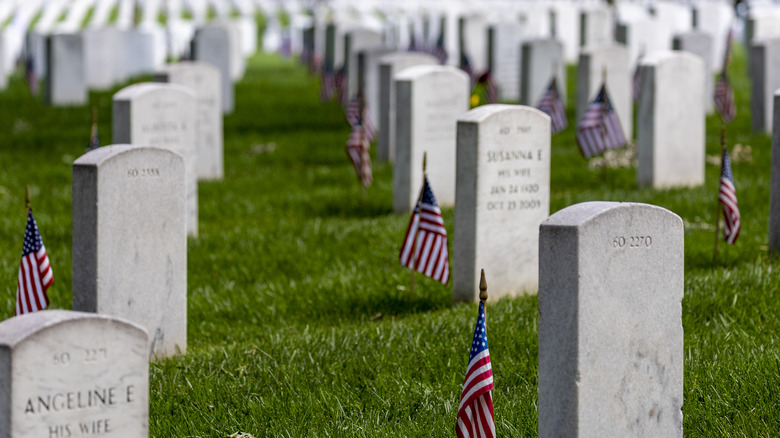Heartbreaking Findings In The Autopsy Of Capitol Police Officer Brian Sicknick
January 6, 2021, will go down in the American history books as a day of violence and terror against lawmakers (per The Washington Post). Hundreds of people, some armed with weapons, breached the United States Capitol building to try and stop Congress from formalizing Joe Biden's victory over outgoing president Donald Trump. The United States Attorney's Office reports that the event caused $1.5 million in damages to the Capitol building, and more than 700 people were arrested in the aftermath of the attack on lawmakers.
But the human cost was far higher. Five people died at the Capitol on January 6 or in the following days, including Capitol Police Officer Brian Sicknick, (via The New York Times). According to Dignity Memorial, Brian Sicknick was a New Jersey native who studied criminal justice in college before dedicating nearly all of his career to public service. He served in the New Jersey Air National Guard before serving in the 108th Security Forces Squadron and was deployed overseas for several years. After an honorable discharge, Sicknick joined the United States Capitol Police force in 2008.
The protestors brought weapons — and bear spray
Most days, Brian Sicknick just patrolled the Capitol Building, keeping watch over visitors (via Dignity Memorial). But that all changed on January 6, 2021, when he and every other police officer at the Capitol Building were quickly outnumbered by hundreds of hyped-up protestors trying to enter. The Washington Post reports that around 2:14 p.m., two members of the crowd, Julian Elie Khater and George Pierre Tanios, approached an outdoor terrace at the Capitol Building. In a video that was recorded of the incident, Khater asks Tanios to hand him some bear spray. Nine minutes went by before Khater used the spray on Brian Sicknick and two other Capitol Police officers.
According to The New York Times, bear spray, meant to repel wild animals, is way too strong to be used on humans and is definitely not intended for self-defense against other people. In video footage, Khater sprayed Sicknick with bear spray and/or one of the two pepper sprays he had also brought along. As protestors began to advance, Sicknick and other officers reacted with surprise and pain to the sudden chemical spray attack. Although he was wearing both a bike helmet and a medical face mask, it was a powerful force against the police: the officer next to Sicknick, who was also sprayed, sustained long-lasting chemical burns under her eyes.
Sicknick's cause of death was initially unclear
Brian Sicknick returned to the division office to get help for his injuries, per The New York Times. He texted his brother that although he'd been attacked, he was okay. But he collapsed in the division office nearly eight hours after he'd been sprayed with the bear deterrent (per The Washington Post). After being rushed to the hospital, his condition worsened, and he was put on a ventilator. NPR reports that tragically, Brian Sicknick died the next day, January 7, at 9:30 p.m. He was honored in the Capitol rotunda for his service to the United States.
The Washington Post reports that for the next 14 weeks, confusion prevailed, and no one knew what Brian Sicknick's cause of death really was (via The Wall Street Journal). Capitol Police at first reported that Sicknick had gotten hurt during combat with the protestors and had "succumbed to his injuries." But they also said Sicknick's death wouldn't be investigated as a homicide and wouldn't provide specific details about how he died. Eventually, an autopsy report was released to set the record straight.
Conflicting reports about the events of January 6
Some initial reports incorrectly stated that Brian Sicknick had been battered with a fire extinguisher (per The Washington Post). As journalists scoured video footage of the incident for clues, other officers were hit with fire extinguishers, but Sicknick did not appear to get hit (per The Wall Street Journal).
Brian Sicknick's autopsy, released on April 19, 2021, finally provided the answers that his loved ones were waiting for. The report detailed that Sicknick hadn't had an allergic reaction to the chemical spray. However, just because he didn't have an allergic reaction does not mean it wasn't a factor in his death. NBC News reports that chief medical examiner Francisco Diaz clarified, "All that transpired played a role in his condition." Notably, a blood clot was discovered in Sicknick's brain stem. It had resulted in two strokes. The medical examiner didn't report any other internal or external physical injuries on Sicknick's body.
The final autopsy results
The Washington Post reports that chief medical examiner Francisco Diaz was unable to comment on any other ailments Brian Sicknick might have had due to privacy concerns. The 42-year-old's death was determined to be due to natural causes, reports CBS News. The Capitol Police said the newest information about his death "does not change the fact Officer Brian Sicknick died in the Line of Duty, courageously defending Congress and the Capitol." He was buried in Arlington National Cemetary in April 2021, where his family and the U.S. government honored him as a hero, reports NBC News.
The Wall Street Journal reports that Julian Elie Khater and George Pierre Tanios were arrested in March 2021 and have pleaded guilty to numerous charges. The United States Capitol Police reports that the men were charged with eight different counts each in relation to their roles at the Capitol Building that day.




